Complete Solutions to All Questions of chapter SOUND WAVES of Class 11 book with complete answers and questions
| Class 11 | PHYSICS |
| Chapter | SOUND WAVES |
| HC VERMA | All Questions |
| Number Of Questions | 100 |
| Academic Year | 2023-24 |
A wave of wavelength 0.60 cm is produced in air and it travels at a speed of 300 ms^-1. Will it be audible?
View SolutionA sound wave of wavelength 40 cm travels in air. If the difference between the maximum and minimum pressures at a given point is `1.0xx10^-3Nm^-2`, find the amplitude of vibration of the particle o the medium. The bulk modulus of air is `1.4xx10^5Nm^-2`.
View SolutionThe pressure amplitude in a sound wave from a radio receiver is `2.0xx10^-2 Nm^-2` and the intensity at a point is `5.0xx10^-7Wm^-2.` If by turning the volume knob the pressure amplitude is increased to `2.5xx10^-2Nm^-2` evaluate intensity.
View SolutionIf the intensity increased by a factor of 20, byhow may decibels is the sound level increased?
View SolutionTwo sound waves, originating from the same source, travel along different paths in air and then meet at a point. If the source vibrates at a frequency of 1.0 kHz and one path is 83 cm longer than the other, what will be the nature of interference? The speed of sound in air is `332 ms^-1`.
View SolutionAn air column is constructed by fitting a movable piston in along cylindrical tube. Longitudinal waves are sent in the tube by as tuning fork of frequency 416 Hz. How far from the open end should the piston, be so that the air column in the tube may vibrate in its first overtone? Speed of sound in air is `333ms^-1`.
View SolutionA tuning fork A frequency 384Hz gives 6 beats in 2 seconds when sounded with another tuning fork B. What could be the frequency of B?
View SolutionA sound detector is placed on a railway platform. A train, approaching the platform at a speed of `36 kmh^-1`, sounds its whistle. The detector detects 12.0 kHz is the most dominant frequency in the whistle. If the train stops at the platform and sounds the whistle, what would be the most dominant frequency detected? The speed of sound in air is `340 ms^-1`.
View SolutionAn ultrasound signal of frequency 50 kHz is sent vertically into sea water. The signal gets reflected from the ocean bed and returns to the surface 0.80 s after it was emitted. The speed of sound in sea water is `1500ms^-1`. a) Find the depth of the sea. b) What is the wavelength of this signal in water.
View SolutionAn aero plane is going towards east at a speed of `510 kmh^-1` at a height of 2000 m. At a certain instant, the sound o the plane heard by a ground observer appears to come from a point vertically above him. Where is the plane at this instant? Speed of sound in air `=340 ms^-1`
View SolutionA sound wave of frequency 10 kHz is travelling in air with a speed of `340 ms^-1`. Find the minimum separation between two points where the phase difference is `60^@`.
View SolutionOn a winter day sound travels 336 meters in one second. Find the atmosphere temperature. Speed of sound at `0^@C=332ms^-1`.
View SolutionThe constant `gamma` of oxygen as well as for hydrogen is 1.40. If the speed of sound in oxygen is `470 ms^-1,` What wil be the speed in hydrogen at the same temperature and pressure?
View SolutionA microphone of cross sectional area `0.80 cm^2`is placed in front of a small speaker emitting 3.0 W of sound output. If the distance between the microphone and the speaker is 2.0 m how much energy falls on the microphone in 5.0 s?
View SolutionFind the amplitude of the vibration of the particles of air through which a sound wave of intensity `2.0xx10^-6Wm^-2` and frequency 1.0kHz is passing. Density of air =1.2 kgm^-3 and speed of sound in air `=330 ms^-1`.
View SolutionFigure shows a tube structure in which a sound signal is sent from one end and is received at the other end. The semicircular part has a radius of 20.0 cm. The frequency of the sound source can be varied electronically between 1000 and 4000 Hz. Find the frequencies at which maxima of intensity are detected. The speed of sound in air =`340ms^-1`.

View SolutionA source emitting sound of frequency 180 Hz is placed in front of a wall at a distance of 2 m from it. A detector is also placed in front of the wall at the same distance from it. Find the minimum distance between the source and the detector for which the detector detects a maximum of sound. Speed of sound in air `=360ms^-1`.

View SolutionA tuning fork vibrates at `264 Hz`. Find the length of the shortest closed organ pipe that will resonate with the tuning fork. Speed of sound in air is `350ms^-1`.
View SolutionThe fundamental frequency of a closed organ pipe is equal to the first overtone frequency of an open organ pipe. If the length of the open pipe is 60 cm, what is the length closed pipe?
View SolutionA tuning fork vibrating at frequency 800 Hz produces resonance in a resonance column tube. The upper end is open and the lower end is closed by the water surface which can be varied. Successive resonances are observed at lengths 9.75 cm, 31.25 cm and 52.75 cm. Calculate the speed of sound in air from these data.
View SolutionA certain organ pipe resonates in its fundamental mode at a frequency of 500 Hz in air. What will be the fundamental frequency if the air is replaced by hydrogen at the same temperature? The density of air is `1.20kgm^-3` and that of hydrogen is `0.089 kgm^-3`.
View SolutionAn aluminium rod having a length of 90.0 cm is clamped at its middle point and is set into longitudinal vibrations by stroking it with a rosined cloth. Assume that the rod vibrates in its fundmental mode of vibration. The density of aluminium is `2600 kgm^-3` and its Young's modulus is `7.80xx10^10 Nm^-2`. Find a. The speed of sound in aluminium, b. The wavelength of sound waves produced in the rod. c. The frequency of the sound produced and d. The wavelength of the sound produced in air. Take the speed of sound in air to be `340 ms^-1`.
View SolutionThe string of violin emits a note of 440 Hz at its correct tension. The string is bit taut and produces 4 beats per second with a tuning fork of frequency 440 Hz. Find the frequency of the note emitted by this taut string.
View SolutionA siren is fitted on as car going towards a vertical wall at a speed of 36 km/h. A person standing on the ground, behind the car, listens to the siren sound coming directly from the source as well as that coming after refelction from the siren to the person and b. coming after reflection. Take the speed of sound to be `340ms^-1`
View SolutionTwo trains are moving towards each other at speeds of `72kmh^-1` and `54 kmh^-1` relative to the ground. The first train sounds a whistle of frequency 600 Hz. Find the frequency of the whistle as heard by a passenger in the second train a. before the trains meet and b. after the trains have crossed each other. The speed of sound in air is `340 ms^-1`
View SolutionA person going away from a factory on his scooter at a speedof `36 kmh^-1` listens to the siren of the factory. If the main frequency of the siren is 600 hz and a wind is blowing alongthe direction of the scooter at `36 kmh^-1`, find the main frequency as heard by the person.
View SolutionA source and a detector move away from each other, each with a speed of `10 ms^-1` with respect to the ground with no wind. If the detector detects a frequency 1950 Hz of the sound coming from the source, what is the original frequency of the source? Speed of sound in air `=340 ms^-1`.
View SolutionThe driver of as car approaching a vertical wall notices that the frequency of his car's horn charges from 440 Hz to 480 Hz when it gets reflected from the wal. Find the speed of the car if that of the sound is `330 ms^-1`.
View SolutionA train approachign a railway crossing at a speed of `120 kmh^-1` sounds a short whistle at frequency 640 Hz when it is 300 m away from the crossing. The speed of sound in air is `340 ms^-1`. What will be the frequency heard by a person standing on a road perpendicular to the track through the crossing at a distance of 400 m from the crossing ?
View SolutionIf you are walking on the moon, can you hear the sound of stones cracking behind you ? Can you hear the sound of your own footsteps ?
View SolutionCan you hear your own words if you are standing in a perfect vacuum ? Can you hear your, friend in the same conditions ?
View SolutionA vertical rod is hit at one end. What kind of wave propagates in the rod if (a) the hit is made vertically (b) the hit is made horizontally ?
View SolutionTwo loudspeakers are arranged facing each other at some distance. Will a person standing behind one of the loudspeakers clearly hear the sound of the other loudspeaker or the clarity will be seriously damaged because of the 'collision' of the two sounds in between ?
View SolutionThe voice of a person, who has inhaled helium, has a remarkably high pitch. Explain on the basis of resonant vibration of vocal cord filled with air and with helium.
View SolutionDraw a diagram to show The standing pressure wave and standing displacement wave for the 3rd overtone mode of vibration of an open organ pipe.
View SolutionTwo tuning forks vibrate with the same amplitude but the frequency of the first is double the frequency of the second. Which fork produces more intense sound in air ?
View SolutionIn discussing Doppler effect, we use the word "apparent frequency". Does it mean that the frequency of the sound is still that of the source and it is some physiological phenomenon in the listener's ear that gives rise to Doppler effect ? Think for the observer approaching the source and for the source approaching the observer.
View SolutionConsider the following statements about and passing through a gas.
A. the pressure of the gas at a point oscillates in time.
B. The position of a small layer of the gas oscillates in time.
View SolutionWhen we clap our hands, the sound produced is best described by Here p denotes the change in pressure from the equilibrium value
View SolutionThe bulk modulus and the density of water are greater than those of air. With this much of information, we can say that velocity of sound in air
View SolutionA tuning fork sends sound waves in air. If the temperature of the air increases, which of the following parameters will changes?
View SolutionWhen sound wave is refracted from air to water, which of following will remain unchanged ?
View SolutionThe speed of sound in a medium depends upon __________ .
View SolutionTwo sound waves moves in the same direction in the same medium. The pressure amplutides of the waves are equal but the wavelength of the first wave is double the second. Let the average power transmitted across a cross section by the first wave be `P_1` and that by the second wave be `P_2` then.
View SolutionWhen two waves with same frequency and constant phase difference interfere,
View SolutionAn open organ pipe of length l vibrates in its fundamental mode. The pressure variation is maximum
View SolutionAn organ pipe, open at both ends, contains
View SolutionA cylinderical tube open at both ends, has a fundamental frequency f in air. The tube is dipped vertically in water so that half of it is in water. The fundamental frequency of air column is now
View SolutionThe phenomenon of beats can take place :
View SolutionA tuning fork of frequency 512 Hz is vibrated with sonometer wire and 6 beats per seconds are heard. The beat frequency reduces if the tension in the string is slightly increased. The original frequency of vibration of the string is
View SolutionThe engine of a train sound a whistle at frequency `v`, the frequency heard by a passenger is
View SolutionThe change in frequency due to Doppler effect does not depend on
View SolutionA small source of sound moves on a circle as shown in figure and an observer is sitting at O. Let `v_1,v_2,v_3` be the frequencies heard when the source is at A,B and C respectively.
 .
.
View SolutionWhen you speak to your friend which of the following parameters have a unique value in the sound produced?
View SolutionAn electrically maintained tuning fork vibrates with constant frequency and constant amplitude. If the temperature of the surrounding air increases but pressure remains constant, the sound produced will have
View SolutionThe fundamental frequency of a vibrating organ pipe is 200 Hz.
View SolutionA source of sound moves towards an observer
View SolutionA listener is at rest with respect to the source of sound. A wind starts blowing along the line joining the source and the observer. Which of the following quantities do not change?
View SolutionA steel tube of length 1.00 m is struck at one end. A person with his ear close to the other end hears the sound of the blow twice one travelling through the body of the tube and the other through the air in the tube. Find the time gap between the two hearings.
View SolutionAt a prayer meeting, the disciples sing JAI-RAM JAI-RAM. The sound amplified by a loudspeaker comes back after reflection from a building at a distance of 80 m from the meeting. What maximum time interval can be kept between one JAI-RAM and the next JAI-RAM so that the echo does not disturb a listener sitting in the meeting. Speed of sound in air is `320 m s^-1`.
View SolutionA man stands before a large wall at a distance of 50.0 m and claps his hands at regular intervals. Initially, the interval is large. He gradually reduces the interval and fixes it at a value when the echo of a clap merges with the next clap. If he has to clap 10 times during every 3 seconds, find the velocity of sound in air.
View SolutionA person can hear sound waves in the frequency range 20 Hz to 20 kHz. Find the minimum and the maximum wavelengths of sound that is audible to the person. The speed of sound is `360 m s^-1`.
View SolutionSound waves from a loudspeaker spread nearly uniformly in all directions if the wavelength of the sound is much larger than the diameter of the loudspeaker. (a) Calculate the frequency for which the wavelength of sound in air is ten times the diameter of the speaker if the diameter is 20 cm. (b) Sound is essentially transmitted in the forward direction if the wavelength is much shorter than the diameter of the speaker. Calculate the frequency at which the wavelength of the sound is one tenth of the diameter of the speaker described above. Take the speed of sound to be `340 m s^-1`.
View SolutionThe equation of a travelling sound wave is `y = 6.0 sin (600 t - 1.8 x)` where y is measured in `10^-5m`, t in second and x in metre. (a) Find the ratio of the displacement amplitude of the particles to the wavelength of the wave. (b) Find the ratio of the velocity amplitude of the particles to the wave speed.
View SolutionA sound wave of frequency 100 Hz is travelling in air. The speed of sound in air is `350 ms^-1` (a) By how much is the phase changed at a given point in 2.5 ms ? (b) What is the phase difference at a given instant between two points separated by a distance of 10.0 cm along the direction of propagation ?
View SolutionTwo point sources of sound are kept at a separation of 10 cm. They vibrate in phase to produce waves of wavelength 5.0 cm. What would be the phase difference between the two waves arriving at a point 20 cm from one source (a) on the line joining the sources and (b) on the perpendicular bisector of the line joining the sources ?
View SolutionCalculate the speed of sound in oxygen from the following data. The mass of 22.4 litre of oxygen at STP `(T = 273 K and p = 1.0 xx 10^5N m^-2)` is 32 g, the molar heat capacity of oxygen at constant volume is `C_V= 2.5 R` and that at constant pressure is `C_p = 3.5 R.`
View SolutionThe speed of sound as measured by a student in the laboratory on a winter day is `340 m/s` when the room temperature is `17^@C`. What speed will be measure another student repeating the experiment on a day when the room temperature is `32@C` ?
View SolutionAt what temperature will the speed of sound be double of its value at `0@C ` ?
View SolutionThe absoulte temperature of air in a region linearly increases from `T_1 to T_2` in a space of width d. Find the time taken by a sound wave to go through the region in terms of `T_1, T_2`d and the speed `upsilon` of sound at 273 K. Evalute this time for `T_1 = 280 K, T_2 = 310 K, d 33m and upsilon = 330 m s^(-1)`
View SolutionFind the change in the volume of 1.0 litre kerosene when it is subjected to an extra pressure of `2.0xx 10^5 N m^-2` from the following data. Density of kerosene `= 800 kg m^-3` and speed of sound in kerosene `= 1330 m s^-1`
View SolutionCalculate the bulk modulus of air from the following data about a sound wave of wavelength 35 cm travelling in air. The pressure at a point varies between ` (1.0 xx 10^5+-14)` Pa and the particles of the air vibrate in simple harmonic motion of amplitude ` 5.5 xx 10^-6m`.
View SolutionA source of sound operates at 2.0 kHz, 20 W emitting sound uniformly in all direction. The speed of sound in air is `340 m s^(-1)` at a distance of air is `1.2kgm ^(-3)` What is the intensity at a distance of 6.0 m from the source ?
View SolutionThe intensity of sound from a point source is `1.0 xx 10^-8 Wm^-2`, at a distance of 5.0 m from the source. What will be the intensity at a distance of 25 m from the source ?
View SolutionThe sound level at a point 5.0 m away from a point source is 40 dB. What will be the level at a point 50 m away from the source ?
View SolutionIf the intensity of sound is doubled, by how many decibels does the sound level increase ?
View SolutionSound with intensity larger than 120 dB appears painful to a person. A small speaker delivers 2.0 W of audio output. How close can the person get to the speaker without hurting his ears ?
View SolutionIf the sound level in a room is increased from 50 dB to 60 dB, by what factor is the pressure amplitude increased ?
View SolutionThe noise level in a classroom in absence of the teacher is 50 dB when 50 students are present. Assuming that on the average each student outputs same sound energy per second, what will be the noise level if the number of students is increased to 100 ?
View SolutionIn Quincke's experiment the sound detected is changed from a maximum to a minimum when the sliding tube is moved through a distance of 2.50 cm. Find the frequency of sound if the speed of sound in air is `340 m s^-1`.
View SolutionIn Quincke's experiment, the sound intensity has a minimum value I at a particular position. As the sliding tube is pulled out by a distance of 16.5 mm, the intensity increases to a maximum of 9 I. Take the speed of sound in air to be `330 m s^-1. (a) Find the frequency of the sound source. (b) Find the ratio of the amplitudes of the two waves arriving at the detector assuming that it does not change much between the positions of minimum intensity and maximum intensity.
View SolutionTwo audio speakers are kept some distance apart and are driven by the same amplifier system. A person is sitting at a place 6.0 m from one of the speakers and 6.4 m from the other. If the sound signal is continuously varied from 500 Hz to 5000 Hz, what are the frequencies for which there is a destructive interference at the place of the listener? Speed of sound in air` = 320 ms^-1`
View SolutionA source of sound S and a detector D are placed at some distance from one another. A big cardboard is placed near the detector and perpendicular to the line SD as shown in figure. It is gradually moved away and it is found that the intensity changes from a maximum to a minimum as the board is moved through a distance of 20 cm. Find the frequency of the sound emitted. Velocity of sound in air is `336 m s^-1`.

View SolutionA source S and a detector D are placed at a distance d apart. A big cardboard is placed at a distance `sqrt2d` from the source and the detector as shown in figure. The source emits a wave of wavelength `= d/2` which is received by the detector after reflection from the cardboard. It is found to be in phase with the direct wave received from the source. By what minimum distance should the cardboard be shifted away so that the reflected wave becomes out of phase with the direct wave ?
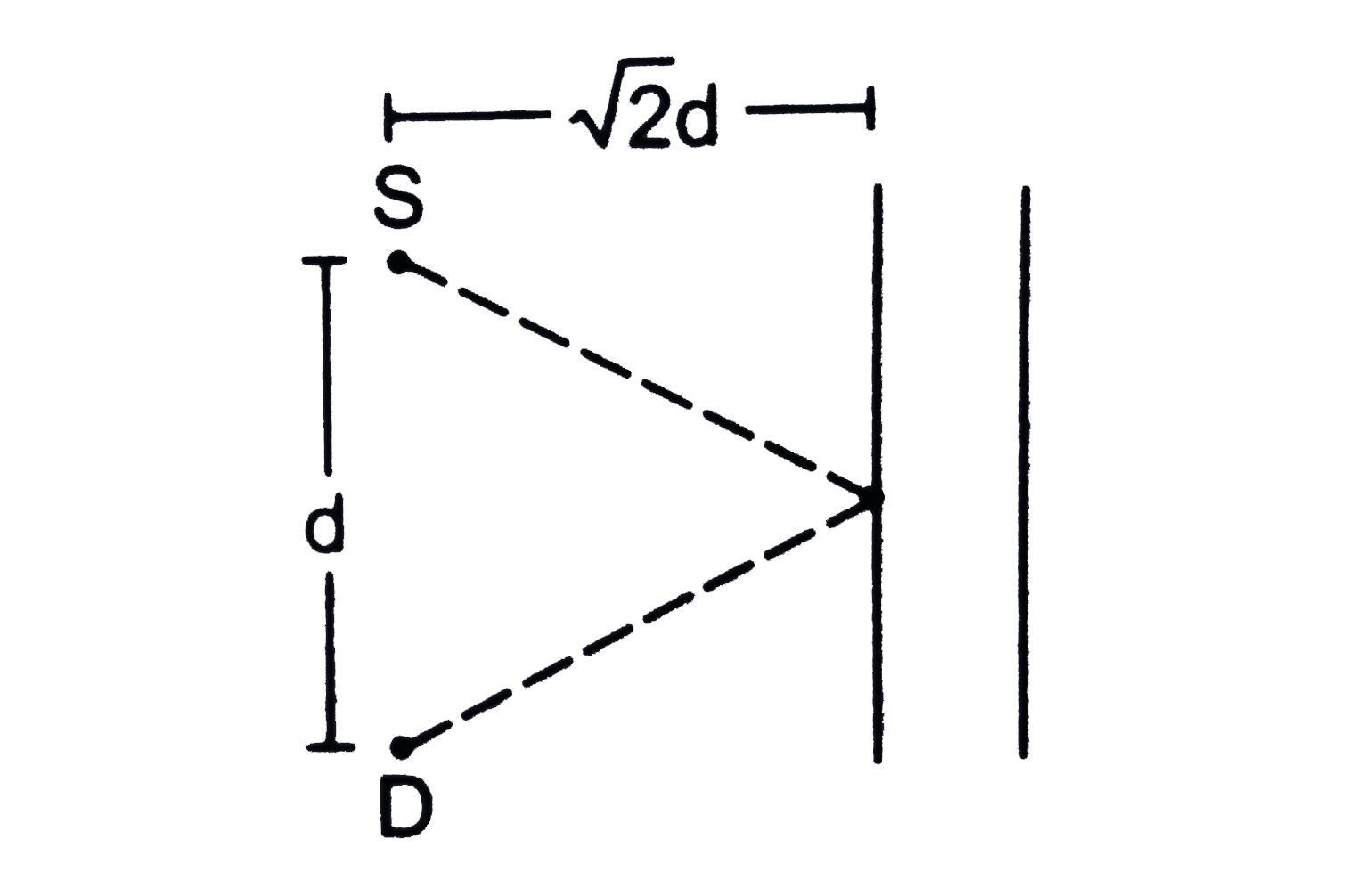
View SolutionTwo stereo speakers are separated by a distance of 2.40 m. A person stands at a distance of 3.20 m directly in front of one of the speakers as shown in figure. Find the frequencies in the audible range (20-2000 Hz) for which the listener will hear a minimum sound intensity. Speed of sound in air `= 320 ms^-1`
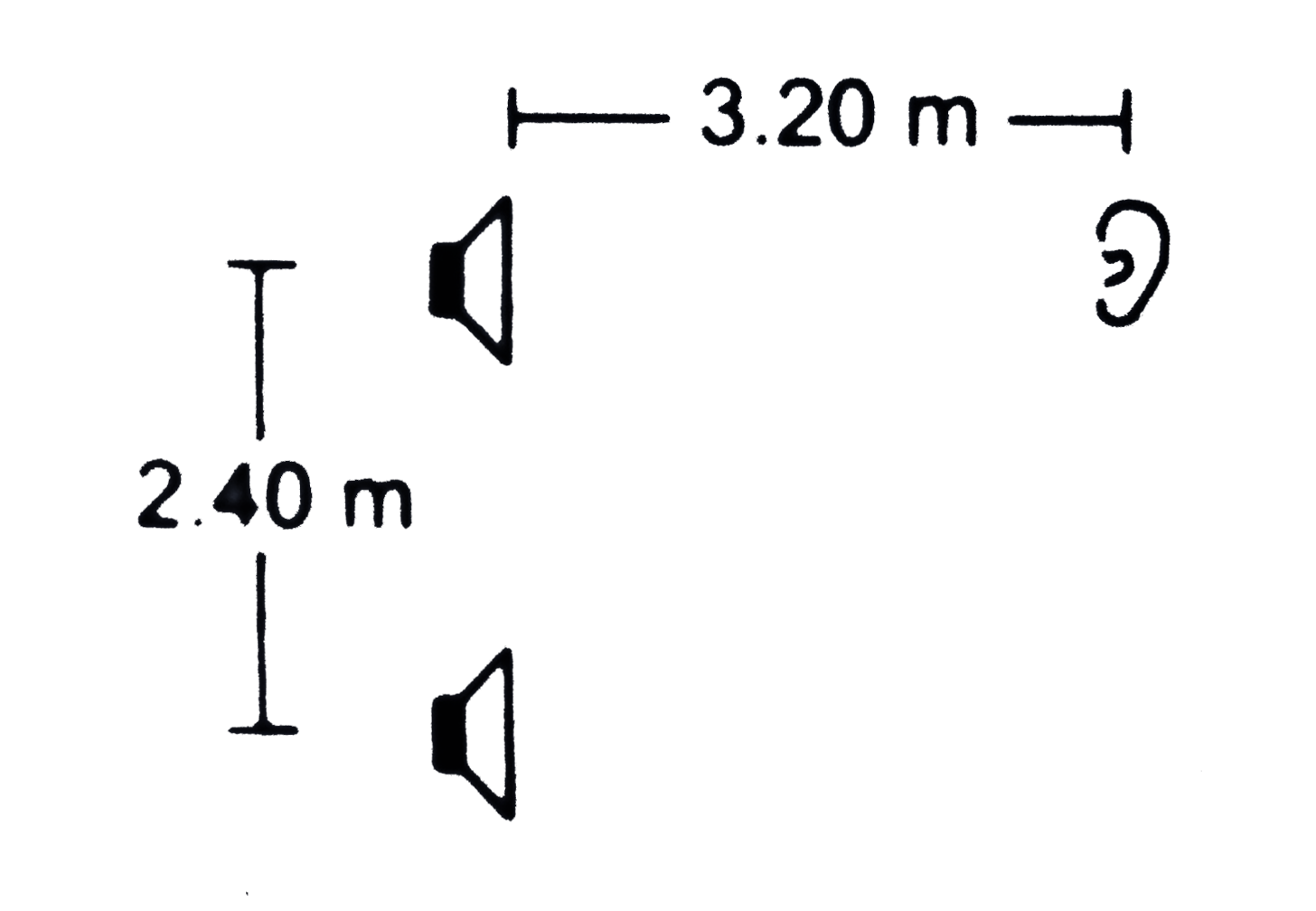
View SolutionTwo speakers `S_(1) and S_(2)` derived by the same amplifier and placed at `y = 1.0 m and y = - 1.0 m` (Fig . 7.9) The speakers vibrate in phase at `600 Hz`. A man stands at a point on the x - axis at a very large distance from the origin and starts moving parallel to the Y - axis . The speed of sound in air is `330 m//s`.
(a). At what angle will the intensity of sound drop to a minimum for the first time ?
(b) At what angle will the sound intensity be maximum for the first time ?
(c ) If he continues to walk along the line , how many more maxima can he hear ?
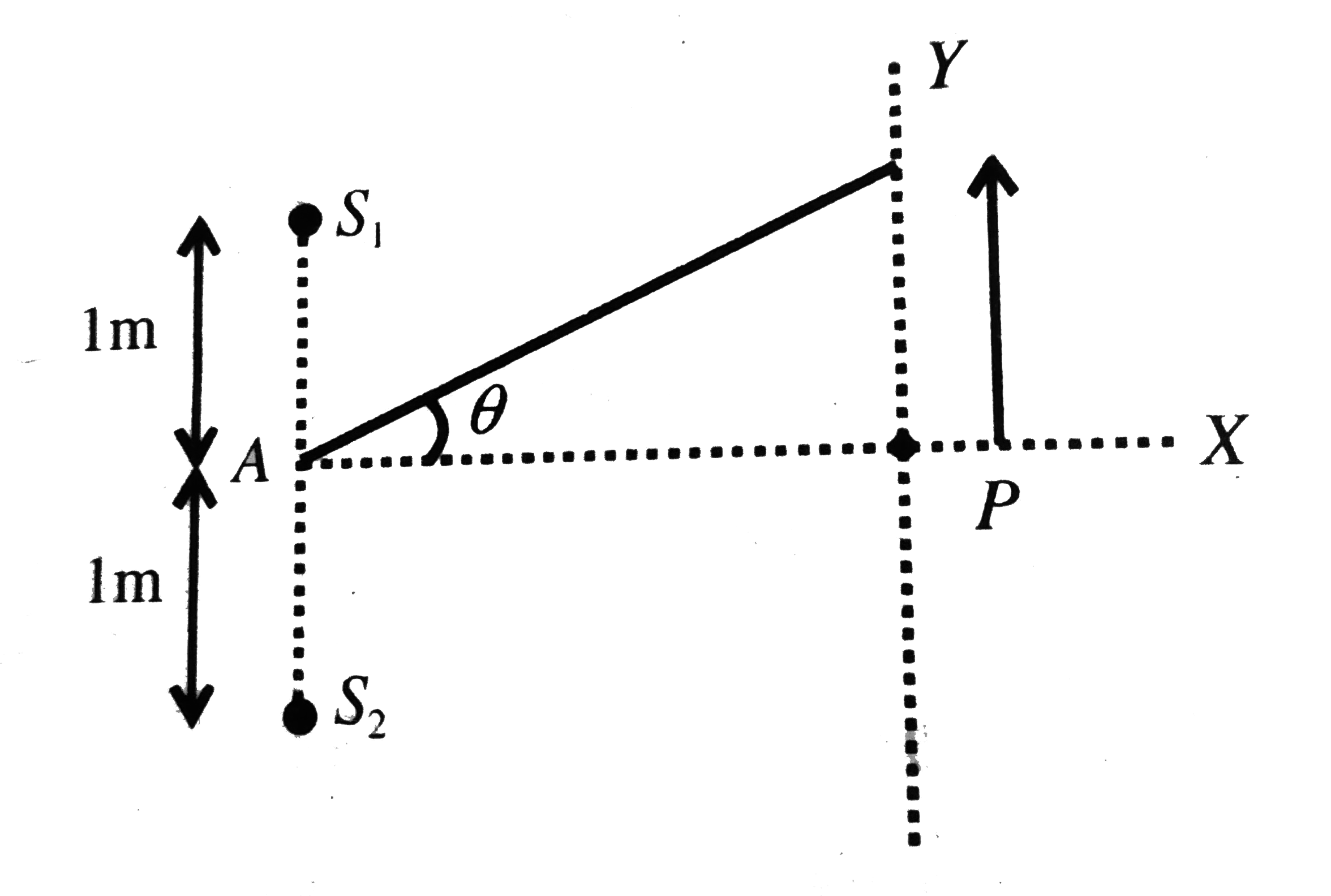
View SolutionThree sources of sound `S_1, S_2 and S_3` of equal intensity are placed in a straight line with `S_1S_2=S_2=S_3`. At a point P. far away from the sources, the wave coming from `S_2 si 120^@` ahead in phase of that from `S_1`. Also, the wave coming from `S_3` is `120^@` ahead of that from `S_2`. What would be the resultant intensity of sound at `P`?

View SolutionTwo coherent narrow slits emitting sound of wavelength `lambda` in the same phase are placed parallet to each other at a small separation of `2 lambda` . The sound is delected by maving a delector on the screen at a distance `D(gt gt lambda)` from the slit `S_(1)` as shows in figure. Find the distance `y` such that the intensity at `P` is equal to intensity at `O` .
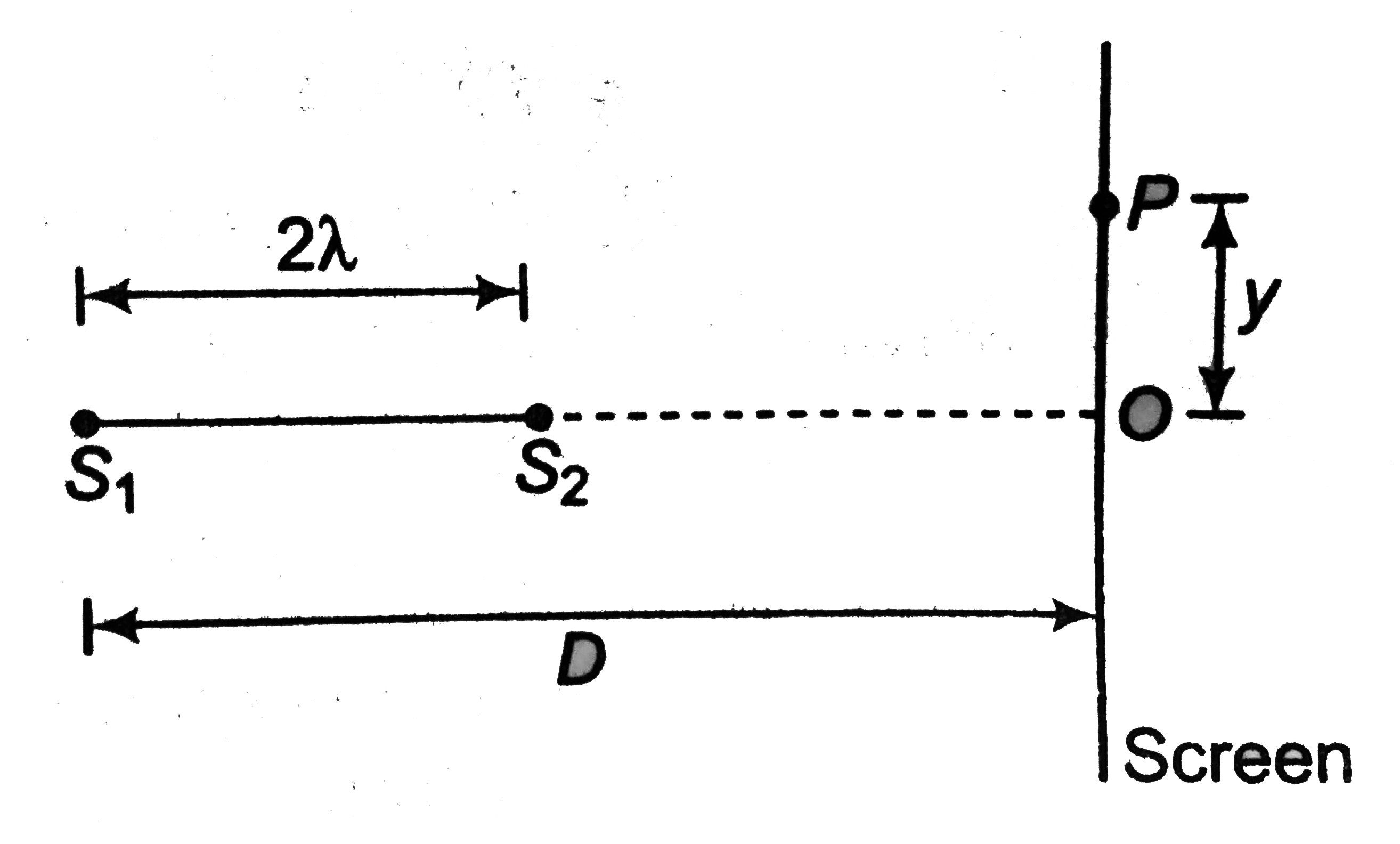
View SolutionFigure shows two coherent sources `S_1 and S_2`which emit sound of wavelength `lamda` in phase. The separation between the sources is `3lamda`. A circular wire at large radius is placed in such a way that `S_1 S_2` lies in its plane and the middle point of `S_1 S_2`, is at the centre of the wire. Find the angular positions 0 on the wire for which constructive interference takes place.
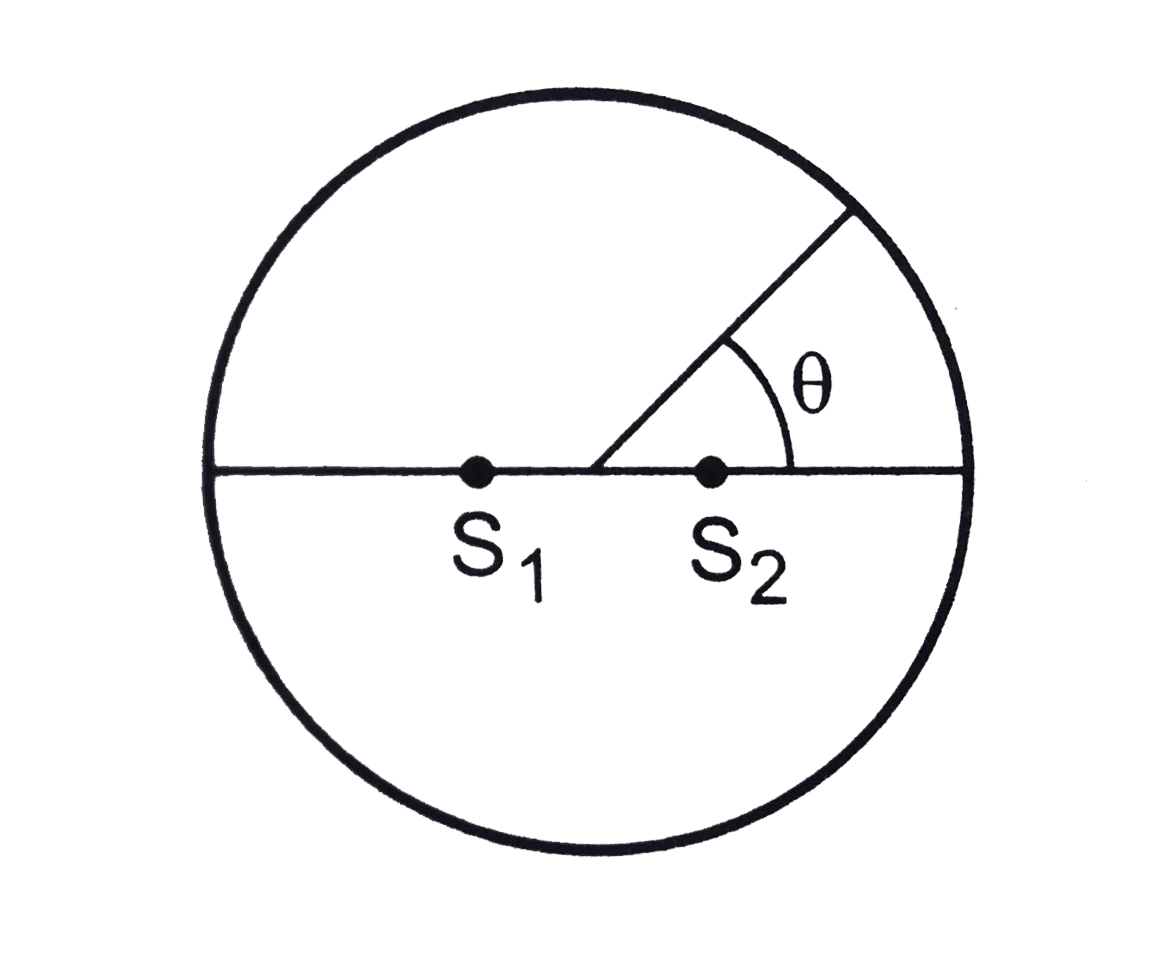
View SolutionFind the fundamental, first overtone and second overtone frequencies of an open organ pipe of length 20 cm. Speed of sound in air is `340 m s^-1`.
View SolutionA closed organ pipe can vibrate at a minimum frequency of 500 Hz. Find the length of the tube. Speed of sound in air `= 340 m s^-1`.
View SolutionIn a standing wave pattern in a vibrating air column, nodes are formed at a distance of 4.0 cm. If the speed of sound in air is` 328 ms^-1` what is the frequency of the source ?
View SolutionThe separation between a node and the next antinode in a vibrating air column is 25 cm. If the speed of sound in air is `340 m s^-1`, find the frequency of vibration of the air column.
View SolutionA cylindrical metal tube has a length of 50 cm and is open at both ends. Find the frequencies between 1000 Hz and 2000 Hz at which the air column in the tube can resonate. Speed of sound in air is `340 m s^-1`.
View SolutionIn a resonance column experiment, a tuning fork of frequency 400 Hz is used. The first resonance is observed when the air column has a length of 20.0 cm and the second resonance is observed when the air column has a length of 62.0 cm. (a) Find the speed of sound in air.(b) How much distance above the open end does the pressure node form ?
View SolutionThe first overtone frequency of a closed organ pipe `P_1` is equal to the fundamental frequency of an open organ pipe `P_2`. If the length of the pipe `P_1` is 30 cm, what will be the length of` P_2`?
View SolutionA copper rod of length 1.0 m is clamped at its middle point. Find the frequencies between 20 Hz and 20,000 Hz at which standing longitudinal waves can be set up in the rod. The speed of sound in copper is `3.8 km s^-1`.
View SolutionFind the greatest length of an organ pipe open at both ends that will have its fundamental frequency in the normal hearing range (20-20,000 Hz). Speed of sound in air `= 340 ms^-1`.
View SolutionAn open organ pipe has a length of 5 cm. (a) Find the fundamental frequency of vibration of this pipe. (b) What is the highest harmonic of such a tube that is in the audible range ? Speed of sound in air is `340 ms^-1` and the audible range is 20-20,000 Hz.
View SolutionAn electronically driven loudspeaker is placed near the open end of a resonance column apparatus. The length of air column in the tube is 80 cm. The frequency of the loudspeaker can be varied between 20 Hz and 2 kHz. Find the frequencies at which the column will resonate. Speed of sound in air `= 320 m s^-1`
View Solution
All Questions questions and complete solutions for chapter SOUND WAVES of HC VERMA of Class 11